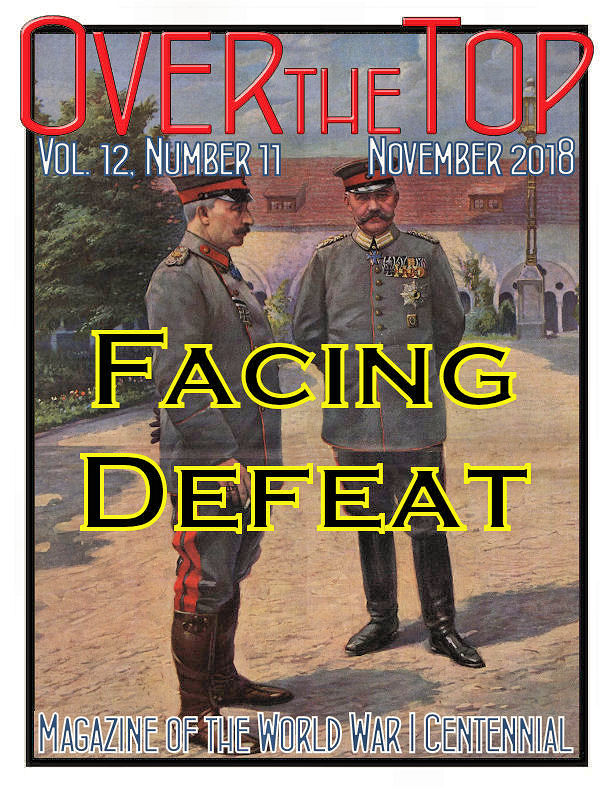
November
2018 |
 |
|
|
Celebrating Our
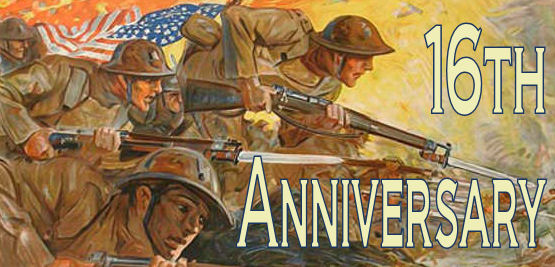


Centennial Wrap
For the past four years, my efforts in all my historical publications have (mostly) involved drawing on the Centennial events of the war as they unfolded. My thinking on this was two-fold: discussing the war over the same timeframe in which it unfolded would give some insights on how the stresses of wartime affected and changed peoples' attitudes over those four years, and, as the anniversary of each major event came, there would be lots of coverage of each of them in the press, television, and movies, generating interest and discussion. Frankly, I've been pretty disappointed on the second of these points, but–be that as it may–with the anniversary of the signing of the Armistice, the Centennial commemorations will effectively end. There are other 100th commemorations yet to come, like the signing of the Versailles Treaty, but there will be nothing comparable, say, to the Battle of the Somme or America's entry into the war. In any case, I plan to continue publishing the St. Mihiel Trip-Wire, but I need to reshape it a bit, eliminating the Centennial emphasis and giving it a fresh look. This might be ready for the December issue, but maybe it will take longer. Nevertheless, I hope you plan to keep subscribing, The First World War–as you well know–is endlessly interesting, and I'll never run out of fascinating material for the Trip-Wire.
MH

|
|
2018
2018 Symposium – 1918: Crucible of War
National WWI Museum & Memorial
Kansas City, MO
1-3 November 2018
Registration & Details: HERE
Bells of Peace National World War I Remembrance
National Air and Space Museum’s
All Across America
At the 11th Hour Locally
11 November 2018
Details: HERE
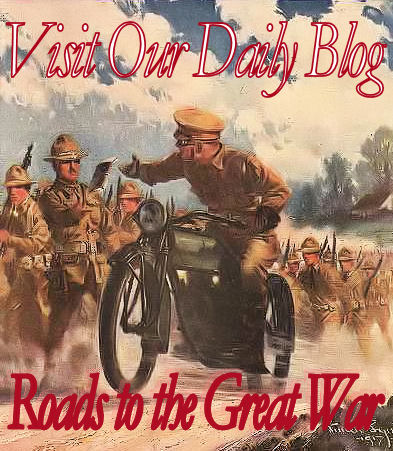
Click on the Image to Visit Our Daily Blog.

As I mentioned last month, despite my retirement from the business, there will still be possibilities for you to visit the battlefields of the Great War.
2019
AEF Battlefields
From: Valor Tours, Ltd. / Mike Grams, Tour Leader
When: September 2019
Details: Request brochure at Email HERE.
Comprehensive Western Front Tour
From: Orinda CA, Travel / Frank Jordan, Tour Leader
When: 19 May – 1 June 2019
Details: Download trip flyer HERE.
|
|
Portrait of the Month
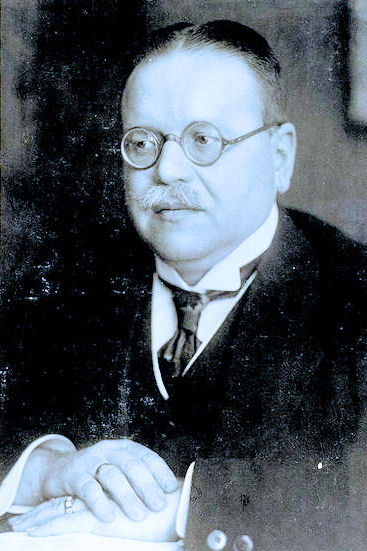
Matthias Erzberger
Erzberger headed the German deputation to the Truce Commission at Compiègne, where, on 11 November, he signed the Armistice.

The War's Last Day
Much was happening on 11 November 1918.
 Emperor Karl I Departs But Doesn't Abdicate
Emperor Karl I Departs But Doesn't Abdicate
 The British Army–with Canadian Forces in the Lead–Returns to Mons
The British Army–with Canadian Forces in the Lead–Returns to Mons
 Henry Gunther, 79th Division, AEF: Last Man Killed in Action
Henry Gunther, 79th Division, AEF: Last Man Killed in Action
 Jozef Pilsudski Assumes Supreme Military Command in Poland
Jozef Pilsudski Assumes Supreme Military Command in Poland
 Battle of Tulgas Begins: British, Canadian, and American Forces in Action in Northern Russia
Battle of Tulgas Begins: British, Canadian, and American Forces in Action in Northern Russia
 Influenza Peaks in U.S. (PDF)
Influenza Peaks in U.S. (PDF)
 Celebrating the Armistice (Images from Around the World)
Celebrating the Armistice (Images from Around the World)

A Number from the Great War
11,000
This is the estimated number of casualties (killed and wounded) suffered by all nations fighting on the Western Front on 11 November 1918.

On the Signing of the Armistice, 11 Nov. 1918
Breathless they paused. Out there men raised their glance
To where had stood those poplars lank and lopped,
As they had raised it through the four years’ dance
Of Death in the now familiar flats of France;
And murmured, 'Strange, this! How? All firing stopped?'
Thomas Hardy, "And There Was a Great Calm"
Purchase My AEF Battlefield Guide
An Electronically Delivered 28-page PDF Document for $14.99
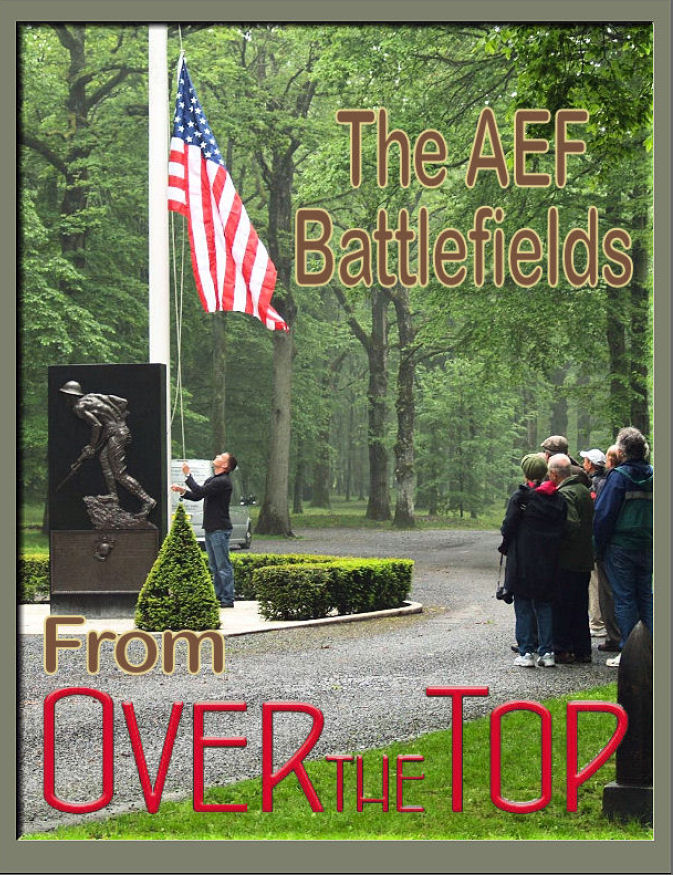 A Concise Summary of the Major U.S. Military Operations of the War with Illustrations, Maps, and GPS Navigational Aids
A Concise Summary of the Major U.S. Military Operations of the War with Illustrations, Maps, and GPS Navigational Aids
(Click Here for Ordering Information)
|
|

|

U.S. Centennial Organizations & Resources
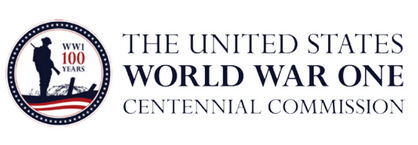
worldwar-1centennial.org/
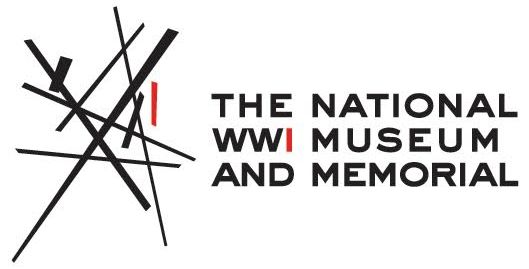
theworldwar.org/
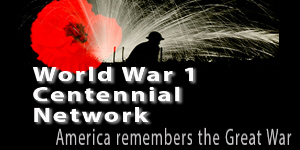
www.ww1-centennial.org/

www.firstdivisionmuseum.org/

www.abmc.gov/
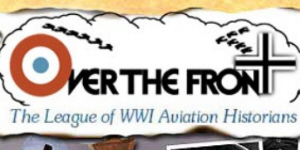
www.overthefront.com/
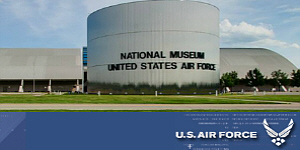
www.nationalmuseum.af.mil/
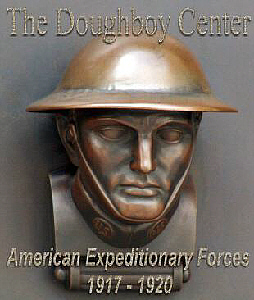
www.worldwar1.com/dbc/
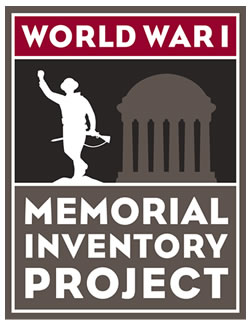
facebook.com/wwiinventory

wisconsinhistory.org/

www.uswarmemorials.org/

www.macarthurmemorial.org/

www.saving-hallowed-ground.org/
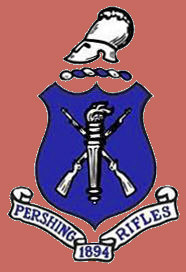
www.theprgroup.org/

pamilmuseum.org/
Support Worldwar1.com's Centennial Effort
Shop at Amazon.com
|
The Centennial Ticker
America Honors Her Airmen
of the Great War
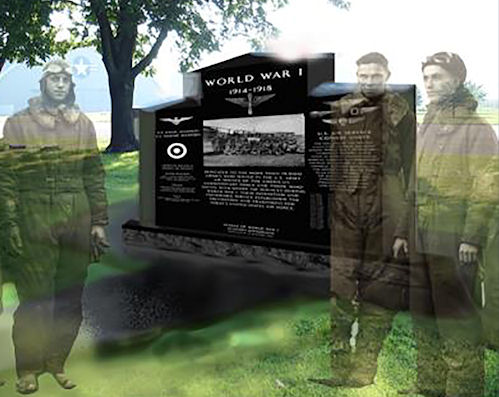
New Memorial for World War I Aviators
On 21 September 2018 on the grounds of the National Museum of the United States Air Force this new memorial was dedicated, honoring the service of America's airmen in the Great War. The memorial was encouraged by and its fundraising effort led by the League of World War I Aviation Historians. Congratulations to the board and members of the League for stepping up and taking the lead on commemorating the service of all the American flyers in the Great War.
The monument honors the more than 78,000 airmen who served the U.S. Army Air Service of the American Expeditionary Force and those who served with other air services during World War I. The combat record of the relatively small Air Service, AEF, was most impressive. It had logged thousands of combat sorties, flown 150 bombing missions, taken more than 18,000 photos of enemy positions, and shot down 781 aircraft and 73 observation balloons. Last, 72 Air Service flyers beaome aces by shooting down at least five enemy planes and/or balloons.
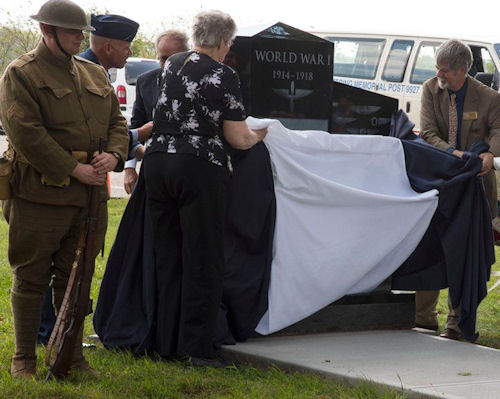
Unveiling Ceremony, 21 September 2018
This success was not without its price. The U.S. lost 289 planes in combat, including 57 piloted by U.S. Air Service flyers attached to British and French units on the Western Front and to Italian units flying against the Austrians over the Alps. Personnel losses were heavy–237 U.S. flyers gave their lives in action, while 279 were wounded.
Sources: League of WWI Aviation Historians & the National Museum of the USAF
Washington D.C.,
11 November 2018
At the National Cathedral

Washington D.C.,
8-12 November 2018
At Pershing Square
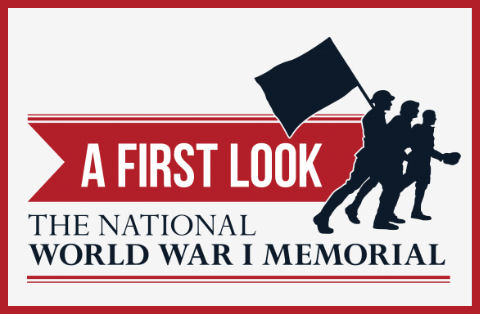
The World War One Centennial Commission invites the public to visit Pershing Park, future site of the National World War Memorial, Washington, DC, between 8 and 12 November 8 for a “First Look at the National World War l Memorial.”
The Memorial site will be open to the public beginning with a presentation of colors at 9 a.m. and concluding with “Taps” at sunset daily, 8-12 November. Visitors will see the memorial design, learn where the memorial will be constructed, and learn how to be part of the project.
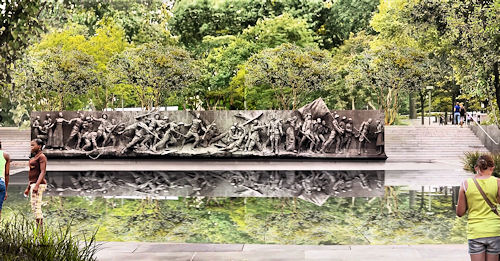
Sabin Howard's Magnificent Sculpture, "A Soldier's Journey," Will Be the Centerpiece of the Completed Memorial
The “First Look” program will also include this series of special events:
Thursday, 8 November
11 a.m. – Wreath Laying Tribute to the States and Territories
2 p.m. – Women in Wartime
4 p.m. – African Americans and Latinos of WW1
Saturday, 10 November
11 a.m. – Native Americans of WW1
Sunday, 11 November
2 p.m. – Military and Veteran Salute
Monday, 12 November
Starts 10 a.m. – WW1 Armistice Film Festival
Reserve a seat for an event – Click Here

1 November 1918
America Launches Its Most Important
Operation
of the World War
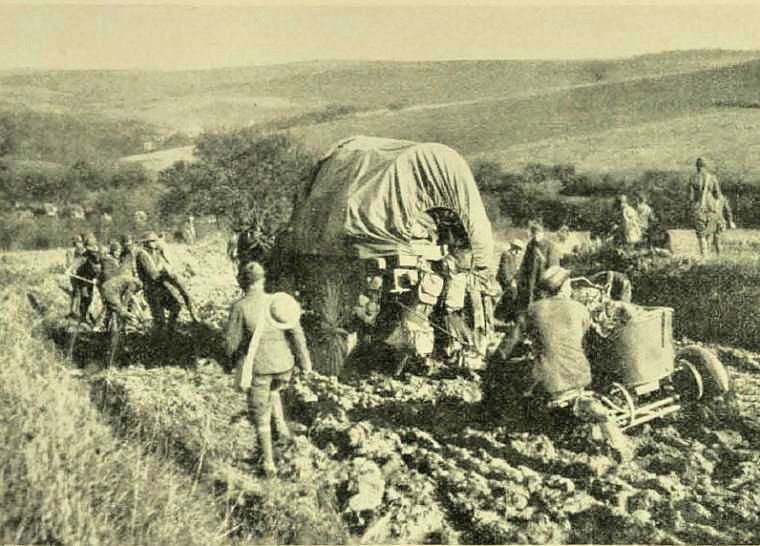
Barricourt Heights, Initial Objective of the 1 November Attack
The Meuse-Argonne Offensive, launched on 26 September, was the largest battle ever fought by American arms. The initial advance through the sector's well-fortified,
densely forested and hilly terrain went slowly. By mid-October the U.S. First Army was bogged down along a
25-mile front, still facing strong German positions. The
offensive's strategic objective, the rail center of Sedan,
was still unthreatened. Other dynamics, however, were
in play. General Pershing, to his credit, accepted he had
reached a limit to his "span of control." He had too many
responsibilities to focus solely on consummating the
Argonne campaign. He chose wisely in selecting Hunter
Liggett to replace him as commander of the First Army.
Additionally, senior officers who had distinguished
themselves at the divisional level–men who had
learned the weaknesses of the official AEF doctrine and
were determined to find new solutions–were raised to
critical posts. Most notable were three future army
chiefs of staff: Major Generals Charles Summerall and
John Hines, named to command the V and III Corps,
respectively, and Colonel George Marshall, operations
chief (G-3) for the First Army.
This new team came together just after Liggett assumed
First Army command on 15 October 1918. In two weeks–while still mounting local attacks throughout the
Argonne region–they would conceive, plan, and mount
on 1 November the most successful American attack of
the Great War. Within a week, a victorious First Army
would find itself on the heights dominating Sedan,
shifting its attention to the east for its next push through
the Metz corridor toward the Rhine.
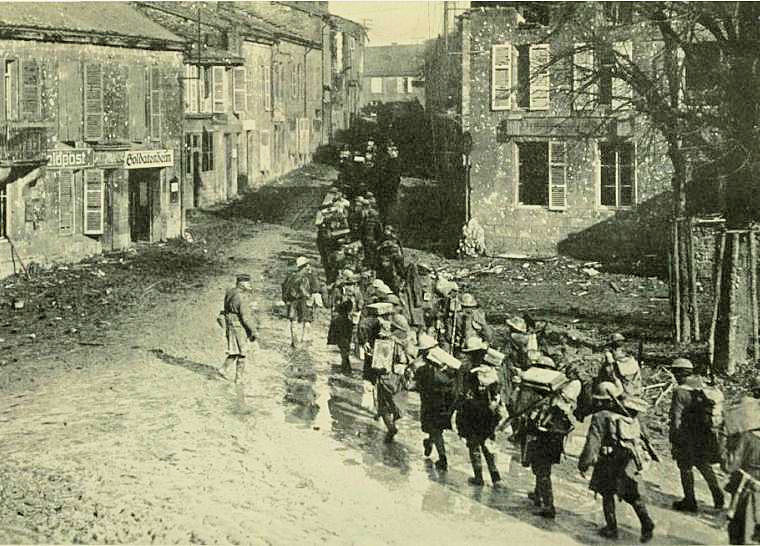
Troops on a Rapid Advance Through Buzancy, 3 November 1918
The attack of 1 November was the most important and
influential operation of the war for the American
military. In the 11 days up to the
Armistice, the 2nd Division of V Corps alone advanced some 29
kilometers, capturing over 1,700 prisoners and 105
artillery pieces. It convinced the future leaders, thinkers, and
commanders of the army that the best way to take
objectives and keep casualties to a minimum was to
overwhelm the enemy with firepower. Remarkably, six future chiefs of staff of the Army and two Marine Corps commandants played major roles in planning or executing the attack of 1 November 1918.
The legacy of the 1 November attack lived on to and after the Second
World War, helping define a new and unique "American
Way of War." Today, as America faces a new century and
is fighting new wars, there could be little doubt that its
reliance on firepower has been one of the Great War's
fundamental legacies on American combat doctrine.
Sources: Mark E. Grotelueschen, Over the Top, September 2008
|
|
|
|
|
Thanks to each and every one of you who has contributed material for this issue. Until our next issue, your editor, Mike Hanlon. |
|
 (Or send it to a friend)
(Or send it to a friend)
|
Design by Shannon Niel
Content © Michael E. Hanlon
|
|
|








